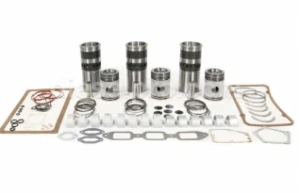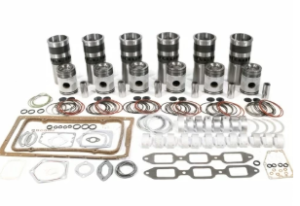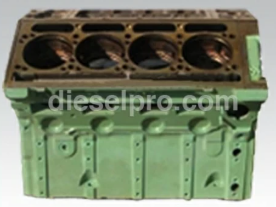
Engine Configurations: Overview of Inline and V-Type Detroit Diesel 53 Series Engine Models (2-53, 3-53, 4-53, 6V-53, and 8V-53)
The Detroit Diesel 53 Series engines are iconic in the world of diesel power, known for their rugged design, reliability, and adaptability across a wide range of applications. The series includes both inline and V-type configurations, each designed to meet specific operational needs. In this article, we’ll explore the configurations, applications, and specifications of these engines to understand their versatility and engineering excellence.
Parts Catalog for 353 Detroit Diesel Marine Engine
Parts Catalog for 453 Detroit Diesel Marine Engine
Parts Catalog for 6V53 Detroit Diesel Marine Engine
Parts Catalog for 8V53 Detroit Diesel Marine Engine
Inline Engine Models
Detroit Diesel’s inline engines in the 53 Series lineup—2-53, 3-53, and 4-53—are compact, efficient, and designed for applications requiring reliability in smaller footprints. These engines share common design principles, including a robust two-stroke cycle, modular construction, and straightforward maintenance.
2-53 Engine Configuration
Specifications
- Cylinders: 2
- Bore: 3.875 inches (98 mm)
- Stroke: 4.5 inches (114 mm)
- Displacement: 106 cubic inches (1.74 liters)
- Compression Ratio:
- Naturally Aspirated (N): 21:1
- Turbocharged (T): 18.7:1
- Firing Order: 1-2
Applications
The 2-53 is the smallest engine in the 53 Series and is often used in applications where size and weight are critical. These include:
- Generator Sets: Providing power for remote locations and industrial facilities.
- Agricultural Equipment: Powering small tractors and irrigation systems.
- Marine Applications: Auxiliary power units for small vessels.
Advantages
- Compact Size: Its small footprint allows installation in confined spaces.
- Fuel Efficiency: The two-cylinder design is highly economical for low-power applications.
3-53 Engine Configuration

Specifications
- Cylinders: 3
- Bore: 3.875 inches (98 mm)
- Stroke: 4.5 inches (114 mm)
- Displacement: 159 cubic inches (2.61 liters)
- Compression Ratio:
- Naturally Aspirated (N): 21:1
- Turbocharged (T): 18.7:1
- Firing Order:
- Right-Hand Rotation: 1-3-2
- Left-Hand Rotation: 1-2-3
Applications
The 3-53 engine is widely used in medium-duty applications requiring moderate power output. Typical uses include:
- Construction Equipment: Skid steers, backhoes, and small excavators.
- Industrial Applications: Compressors and pumps.
- Marine Applications: Auxiliary engines for mid-sized boats.
Advantages
- Power-to-Weight Ratio: The three-cylinder design balances power output with a manageable size.
- Reliability: Proven performance in demanding environments.
Overhaul Kit for Detroit Diesel 353 Non – Turbo Marine & industrial Engines
Water Pump for Detroit Diesel 353 Non – Turbo Marine & industrial Engines
Marine Raw Water Pump for Detroit Diesel 353 Non – Turbo Marine & industrial Engines
Cylinder Head for Detroit Diesel 353 Non – Turbo Marine & industrial Engines
Fuel Pump for Detroit Diesel 353 Non – Turbo Marine & industrial Engines
Injectors for Detroit Diesel 353 Non – Turbo Marine & industrial Engines
Blower for Detroit Diesel 353 Non – Turbo Marine & industrial Engines
Oil Pump for Detroit Diesel 353 Non – Turbo Marine & industrial Engines
Crankshaft for Detroit Diesel 353 Non – Turbo Marine & industrial Engines
Connecting Rod for Detroit Diesel 353 Non – Turbo Marine & industrial Engines
Camshaft for Detroit Diesel 353 Non – Turbo Marine & industrial Engines
Exhaust Manifold for Detroit Diesel 353 Non – Turbo Marine & industrial Engines
Gaskets for Detroit Diesel 353 Non – Turbo Marine & industrial Engines
Cylinder Kit for Detroit Diesel 353 Non – Turbo Marine & industrial Engines
Starters & Alternators for Detroit Diesel 353 Non – Turbo Marine & industrial Engines
Fuel Filters for Detroit Diesel 353 Non – Turbo Marine & industrial Engines
Oil Filters for Detroit Diesel 353 Non – Turbo Marine & industrial Engines
Overhaul Kit for Detroit Diesel 353 Turbo Marine & industrial Engine
Water Pump for Detroit Diesel 353 Turbo Marine & industrial Engine
Marine Raw Water Pump for Detroit Diesel 353 Turbo Marine & industrial Engine
Cylinder Head for Detroit Diesel 353 Turbo Marine & industrial Engine
Fuel Pump for Detroit Diesel 353 Turbo Marine & industrial Engine
Injectors for Detroit Diesel 353 Turbo Marine & industrial Engine
Turbo for Detroit Diesel 353 Turbo Marine & industrial Engine
Blower for Detroit Diesel 353 Turbo Marine & Industrial Engine
Oil Pump for Detroit Diesel 353 Turbo Marine & industrial Engine
Crankshaft for Detroit Diesel 353 Turbo Marine & industrial Engine
Connecting Rod for Detroit Diesel 353 Turbo Marine & industrial Engine
Camshaft for Detroit Diesel 353 Turbo Marine & industrial Engine
Exhaust Manifold for Detroit Diesel 353 Turbo Marine & industrial Engine
Gaskets for Detroit Diesel 353 Turbo Marine & industrial Engine
Cylinder Kit for Detroit Diesel 353 Turbo Marine & industrial Engine
Starters & Alternators for Detroit Diesel 353 Turbo Marine & industrial Engine
Fuel Filters for Detroit Diesel 353 Turbo Marine & industrial Engine
Oil Filters for Detroit Diesel 353 Turbo Marine & industrial Engine
4-53 Engine Configuration

Specifications
- Cylinders: 4
- Bore: 3.875 inches (98 mm)
- Stroke: 4.5 inches (114 mm)
- Displacement: 212 cubic inches (3.48 liters)
- Compression Ratio:
- Naturally Aspirated (N): 21:1
- Turbocharged (T): 18.7:1
- Firing Order:
- Right-Hand Rotation: 1-3-4-2
- Left-Hand Rotation: 1-2-4-3
Applications
The 4-53 engine is the most powerful inline configuration in the 53 Series and supports heavy-duty tasks. Common applications include:
- Marine Propulsion: Powering small fishing vessels and workboats.
- Industrial Equipment: Cranes, winches, and larger compressors.
- Military Applications: Used in light armored vehicles and transport equipment.
Advantages
- Increased Power: The four-cylinder setup delivers robust performance for heavy workloads.
- Versatility: Suitable for both stationary and mobile operations.
Overhaul Kit for Detroit Diesel 453 Non – Turbo Marine & industrial Engines
Water Pump for Detroit Diesel 453 Non – Turbo Marine & industrial Engines
Marine Raw Water Pump for Detroit Diesel 453 Non – Turbo Marine & industrial Engines
Cylinder Head for Detroit Diesel 453 Non – Turbo Marine & industrial Engines
Fuel Pump for Detroit Diesel 453 Non – Turbo Marine & industrial Engines
Injectors for Detroit Diesel 453 Non – Turbo Marine & industrial Engines
Blower for Detroit Diesel 453 Non – Turbo Marine & industrial Engines
Oil Pump for Detroit Diesel 453 Non – Turbo Marine & industrial Engines
Crankshaft for Detroit Diesel 453 Non – Turbo Marine & industrial Engines
Connecting Rod for Detroit Diesel 453 Non – Turbo Marine & industrial Engines
Camshaft for Detroit Diesel 453 Non – Turbo Marine & industrial Engines
Exhaust Manifold for Detroit Diesel 453 Non – Turbo Marine & industrial Engines
Gaskets for Detroit Diesel 453 Non – Turbo Marine & industrial Engines
Cylinder Kit for Detroit Diesel 453 Non – Turbo Marine & industrial Engines
Starters & Alternators for Detroit Diesel 453 Non – Turbo Marine & industrial Engines
Fuel Filters for Detroit Diesel 453 Non – Turbo Marine & industrial Engines
Oil Filters for Detroit Diesel 453 Non – Turbo Marine & industrial Engines
Overhaul Kit for Detroit Diesel 453 Turbo Marine & industrial Engine
Water Pump for Detroit Diesel 453 Turbo Marine & industrial Engine
Marine Raw Water Pump for Detroit Diesel VTurbo Marine & industrial Engine
Cylinder Head for Detroit Diesel 453 Turbo Marine & industrial Engine
Fuel Pump for Detroit Diesel 453 Turbo Marine & industrial Engine
Injectors for Detroit Diesel 453 Turbo Marine & industrial Engine
Turbo for Detroit Diesel 453 Turbo Marine & industrial Engine
Blower for Detroit Diesel 453 Turbo Marine & Industrial Engine
Oil Pump for Detroit Diesel 453 Turbo Marine & industrial Engine
Crankshaft for Detroit Diesel 453 Turbo Marine & industrial Engine
Connecting Rod for Detroit Diesel V Turbo Marine & industrial Engine
Camshaft for Detroit Diesel 453 Turbo Marine & industrial Engine
Exhaust Manifold for Detroit Diesel 453 Turbo Marine & industrial Engine
Gaskets for Detroit Diesel 453 Turbo Marine & industrial Engine
Starters & Alternators for Detroit Diesel 453 Turbo Marine & industrial Engine
Fuel Filters for Detroit Diesel 453 Turbo Marine & industrial Engine
Oil Filters for Detroit Diesel 453 Turbo Marine & industrial Engine
V-Type Engine Models
The V-type engines in the 53 Series—6V-53 and 8V-53—are designed for high-power applications where performance and durability are paramount. These configurations combine the efficiency of the two-stroke cycle with a compact, space-saving V layout.
6V-53 Engine Configuration

Specifications
- Cylinders: 6 (V-Type, 60° angle)
- Bore: 3.875 inches (98 mm)
- Stroke: 4.5 inches (114 mm)
- Displacement: 318 cubic inches (5.21 liters)
- Compression Ratio:
- Naturally Aspirated (N): 21:1
- Turbocharged (T): 18.7:1
- Firing Order:
- Right-Hand Rotation: 1L-3R-3L-2R-2L-1R
- Left-Hand Rotation: 1L-1R-2L-2R-3L-3R
Applications
The 6V-53 is a high-performance engine used in challenging environments where reliability and power are crucial. Applications include:
- Military Vehicles: Main powerplants for armored personnel carriers and light tanks.
- Marine Propulsion: Engines for tugboats, fishing vessels, and other medium-sized ships.
- Industrial Equipment: Power sources for large pumps, compressors, and specialized machinery.
Advantages
- High Power Output: The six-cylinder V configuration delivers substantial horsepower.
- Compact Design: The V-type layout allows for better space utilization in equipment.
Overhaul Kit for Detroit Diesel 6V53 Non – Turbo Marine & industrial Engines
Water Pump for Detroit Diesel 6V53 Non – Turbo Marine & industrial Engines
Marine Raw Water Pump for Detroit Diesel 6V53 Non – Turbo Marine & industrial Engines
Cylinder Head for Detroit Diesel 6V53 Non – Turbo Marine & industrial Engines
Fuel Pump for Detroit Diesel 6V53 Non – Turbo Marine & industrial Engines
Injectors for Detroit Diesel 6V53 Non – Turbo Marine & industrial Engines
Blower for Detroit Diesel 6V53 Non – Turbo Marine & industrial Engines
Oil Pump for Detroit Diesel 6V53 Non – Turbo Marine & industrial Engines
Crankshaft for Detroit Diesel 6V53 Non – Turbo Marine & industrial Engines
Connecting Rod for Detroit Diesel 6V53 Non – Turbo Marine & industrial Engines
Camshaft for Detroit Diesel 6V53 Non – Turbo Marine & industrial Engines
Exhaust Manifold for Detroit Diesel 6V53 Non – Turbo Marine & industrial Engines
Gaskets for Detroit Diesel 6V53 Non – Turbo Marine & industrial Engines
Cylinder Kit for Detroit Diesel 6V53 Non – Turbo Marine & industrial Engines
Starters & Alternators for Detroit Diesel 6V53 Non – Turbo Marine & industrial Engines
Fuel Filters for Detroit Diesel 6V53 Non – Turbo Marine & industrial Engines
Oil Filters for Detroit Diesel 6V53 Non – Turbo Marine & industrial Engines
Overhaul Kit for Detroit Diesel 6V53 Turbo Marine & industrial Engine
Water Pump for Detroit Diesel 6V53 Turbo Marine & industrial Engine
Marine Raw Water Pump for Detroit Diesel 6V53 Turbo Marine & industrial Engine
Cylinder Head for Detroit Diesel 6V53 Turbo Marine & industrial Engine
Fuel Pump for Detroit Diesel 6V53 Turbo Marine & industrial Engine
Injectors for Detroit Diesel 6V53 Turbo Marine & industrial Engine
Turbo for Detroit Diesel 6V53 Turbo Marine & industrial Engine
Blower for Detroit Diesel 6V53 Turbo Marine & Industrial Engine
Oil Pump for Detroit Diesel 6V53 Turbo Marine & industrial Engine
Crankshaft for Detroit Diesel 6V53 Turbo Marine & industrial Engine
Connecting Rod for Detroit Diesel 6V53 Turbo Marine & industrial Engine
Camshaft for Detroit Diesel 6V53 Turbo Marine & industrial Engine
Exhaust Manifold for Detroit Diesel 6V53 Turbo Marine & industrial Engine
Gaskets for Detroit Diesel 6V53 Turbo Marine & industrial Engine
Cylinder Kit for Detroit Diesel 6V53 Turbo Marine & industrial Engine
Starters & Alternators for Detroit Diesel 6V53 Turbo Marine & industrial Engine
Fuel Filters for Detroit Diesel 6V53 Turbo Marine & industrial Engine
Oil Filters for Detroit Diesel 6V53 Turbo Marine & industrial Engine
8V-53 Engine Configuration

Specifications
- Cylinders: 8 (V-Type, 60° angle)
- Bore: 3.875 inches (98 mm)
- Stroke: 4.5 inches (114 mm)
- Displacement: 424 cubic inches (6.96 liters)
- Compression Ratio:
- Naturally Aspirated (N): 21:1
- Turbocharged (T): 18.7:1
- Firing Order:
- Right-Hand Rotation: 1L-3R-3L-4R-4L-2R-2L-1R
- Left-Hand Rotation: 1L-1R-2L-2R-3L-3R-4L-4R
Applications
The 8V-53 is the largest and most powerful engine in the 53 Series, making it ideal for demanding applications. These include:
- Marine Propulsion: Main engines for larger fishing vessels, tugs, and workboats.
- Military Vehicles: Used in heavier armored vehicles requiring superior power and torque.
- Stationary Power Generation: High-output generators for industrial and remote locations.
Advantages
- Maximum Power: The eight-cylinder configuration provides exceptional horsepower and torque.
- Durability: Built to withstand extreme conditions in demanding applications.
Overhaul Kit for Detroit Diesel 8V53 Non – Turbo Marine & industrial Engines
Water Pump for Detroit Diesel 8V53 Non – Turbo Marine & industrial Engines
Marine Raw Water Pump for Detroit Diesel 8V53 Non – Turbo Marine & industrial Engines
Cylinder Head for Detroit Diesel 8V53 Non – Turbo Marine & industrial Engines
Fuel Pump for Detroit Diesel 8V53 Non – Turbo Marine & industrial Engines
Injectors for Detroit Diesel 8V53 Non – Turbo Marine & industrial Engines
Blower for Detroit Diesel 8V53 Non – Turbo Marine & industrial Engines
Oil Pump for Detroit Diesel 8V53 Non – Turbo Marine & industrial Engines
Crankshaft for Detroit Diesel 8V53 Non – Turbo Marine & industrial Engines
Connecting Rod for Detroit Diesel 8V53 Non – Turbo Marine & industrial Engines
Camshaft for Detroit Diesel 8V53 Non – Turbo Marine & industrial Engines
Exhaust Manifold for Detroit Diesel 8V53 Non – Turbo Marine & industrial Engines
Gaskets for Detroit Diesel 8V53 Non – Turbo Marine & industrial Engines
Cylinder Kit for Detroit Diesel 8V53 Non – Turbo Marine & industrial Engines
Starters & Alternators for Detroit Diesel 8V53 Non – Turbo Marine & industrial Engines
Fuel Filters for Detroit Diesel 8V53 Non – Turbo Marine & industrial Engines
Oil Filters for Detroit Diesel 8V53 Non – Turbo Marine & industrial Engines
Overhaul Kit for Detroit Diesel 8V53 Turbo Marine & industrial Engine
Water Pump for Detroit Diesel 8V53 Turbo Marine & industrial Engine
Marine Raw Water Pump for Detroit Diesel 8V53 Turbo Marine & industrial Engine
Cylinder Head for Detroit Diesel 8V53 Turbo Marine & industrial Engine
Fuel Pump for Detroit Diesel 8V53 Turbo Marine & industrial Engine
Injectors for Detroit Diesel 8V53 Turbo Marine & industrial Engine
Turbo for Detroit Diesel 8V53 Turbo Marine & industrial Engine
Blower for Detroit Diesel 8V53 Turbo Marine & Industrial Engine
Oil Pump for Detroit Diesel 8V53 Turbo Marine & industrial Engine
Crankshaft for Detroit Diesel 8V53 Turbo Marine & industrial Engine
Connecting Rod for Detroit Diesel 8V53 Turbo Marine & industrial Engine
Camshaft for Detroit Diesel 8V53 Turbo Marine & industrial Engine
Exhaust Manifold for Detroit Diesel 8V53 Turbo Marine & industrial Engine
Gaskets for Detroit Diesel 8V53 Turbo Marine & industrial Engine
Cylinder Kit for Detroit Diesel 8V53 Turbo Marine & industrial Engine
Starters & Alternators for Detroit Diesel 8V53 Turbo Marine & industrial Engine
Fuel Filters for Detroit Diesel 8V53 Turbo Marine & industrial Engine
Oil Filters for Detroit Diesel 8V53 Turbo Marine & industrial Engine
Common Features Across Configurations
Despite their differences, all 53 Series engines share several design principles and components that enhance performance and ease of maintenance.
Two-Stroke Cycle Design
The two-stroke cycle enables power production with every revolution of the crankshaft, doubling the power output compared to a four-stroke engine of similar size.
Modular Construction
The modular design simplifies maintenance and repair, as components like cylinder heads, injectors, and blowers are interchangeable across configurations.
Advanced Fuel Injection
The unit injector system delivers precise fuel metering and atomization, ensuring efficient combustion and reducing emissions.
Durability and Longevity
Components are built to withstand high pressures and temperatures, ensuring long service life even under harsh conditions.
Inline vs. V-Type: Key Differences
Performance
- Inline Engines: Offer balanced operation and are ideal for applications requiring moderate power output.
- V-Type Engines: Deliver higher power and torque, making them suitable for heavy-duty applications.
Size and Weight
- Inline Engines: Compact and lightweight, making them easier to install in confined spaces.
- V-Type Engines: Bulkier but provide better power-to-size ratios for large-scale operations.
Maintenance
- Inline Engines: Simpler design makes maintenance straightforward.
- V-Type Engines: More components and a complex layout require meticulous maintenance.
Applications at a Glance
| Model | Power Output | Applications |
| 2-53 | Low | Small tractors, auxiliary marine engines, generators |
| 3-53 | Moderate | Construction equipment, industrial pumps, marine auxiliaries |
| 4-53 | High | Marine propulsion, industrial cranes, military vehicles |
| 6V-53 | Very High | Military vehicles, marine propulsion, industrial power |
| 8V-53 | Maximum | Large marine engines, heavy military vehicles, industrial generators |
Conclusion
Detroit Diesel’s 53 Series inline and V-type engines demonstrate the versatility and engineering excellence required for a wide range of applications. Whether you need a compact solution for a generator or a powerhouse for a military vehicle, the 53 Series has an engine configuration tailored to your needs. Their durability, efficiency, and reliability ensure they remain a trusted choice for decades.
Parts Catalog for 353 Detroit Diesel Marine Engine
Parts Catalog for 453 Detroit Diesel Marine Engine
Parts Catalog for 6V53 Detroit Diesel Marine Engine
Parts Catalog for 8V53 Detroit Diesel Marine Engine



 Free US Calls: 1-888-433-4735
Free US Calls: 1-888-433-4735 International: 305-545-5588
International: 305-545-5588